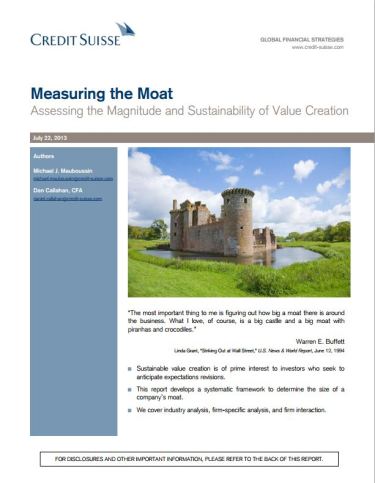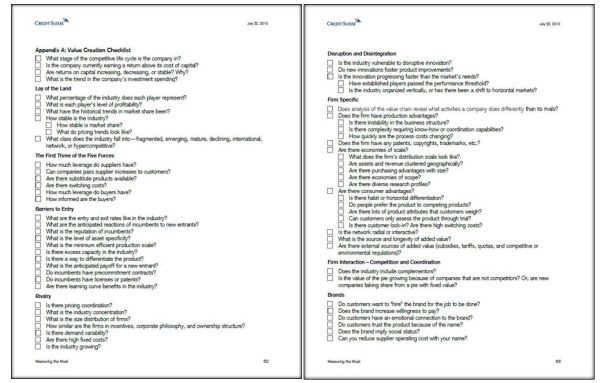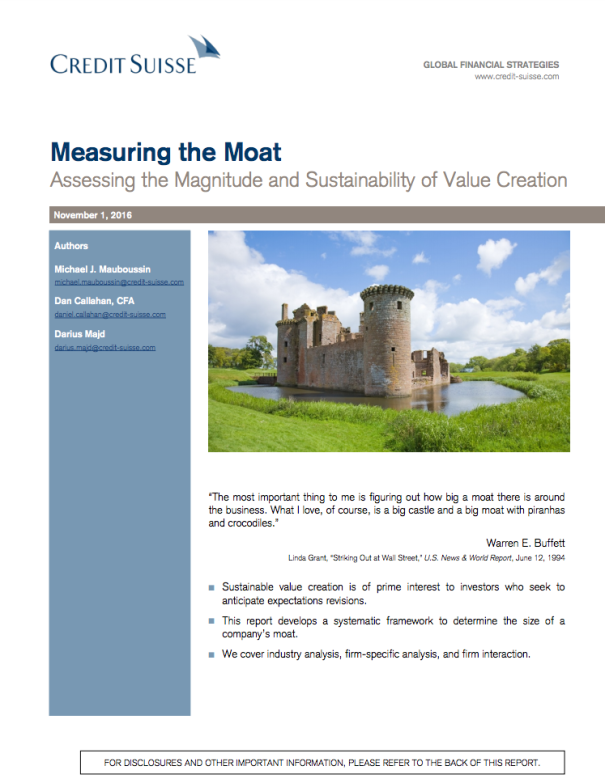“The most important thing to me is figuring out how big a moat there is around the business. What I love, of course, is a big castle and a big moat with piranhas and crocodiles.” ―Warren Buffett

Measuring the Moat: Assessing the Magnitude and Sustainability of Value Creation
Below is an excerpt of “a complete checklist of questions to guide the strategic analysis” published in the paper Measuring the Moat: Assessing the Magnitude and Sustainability of Value Creation, written by Michael J. Mauboussin and Dan Callahan.
See here for full PDF.

Value Creation Checklist
- What stage of the competitive life cycle is the company in?
- Is the company currently earning a return above its cost of capital?
- Are returns on capital increasing, decreasing, or stable? Why?
- What is the trend in the company’s investment spending?
 Lay of the Land
Lay of the Land
- What percentage of the industry does each player represent?
- What is each player’s level of profitability?
- What have the historical trends in market share been?
- How stable is the industry?
- How stable is market share?
- What do pricing trends look like?
- What class does the industry fall into—fragmented, emerging, mature, declining, international, network, or hypercompetitive?
 The First Three of the Five Forces
The First Three of the Five Forces
- How much leverage do suppliers have?
- Can companies pass supplier increases to customers?
- Are there substitute products available?
- Are there switching costs?
- How much leverage do buyers have?
- How informed are the buyers?
 Barriers to Entry
Barriers to Entry
- What are the entry and exit rates like in the industry?
- What are the anticipated reactions of incumbents to new entrants?
- What is the reputation of incumbents?
- What is the level of asset specificity?
- What is the minimum efficient production scale?
- Is there excess capacity in the industry?
- Is there a way to differentiate the product?
- What is the anticipated payoff for a new entrant?
- Do incumbents have precommitment contracts?
- Do incumbents have licenses or patents?
- Are there learning curve benefits in the industry?
 Rivalry
Rivalry
- Is there pricing coordination?
- What is the industry concentration?
- What is the size distribution of firms?
- How similar are the firms in incentives, corporate philosophy, and ownership structure?
- Is there demand variability?
- Are there high fixed costs?
- Is the industry growing?
 Disruption and Disintegration
Disruption and Disintegration
- Is the industry vulnerable to disruptive innovation?
- Do new innovations foster product improvements?
- Is the innovation progressing faster than the market’s needs?
- Have established players passed the performance threshold?
- Is the industry organized vertically, or has there been a shift to horizontal markets?
 Firm Specific
Firm Specific
- Does analysis of the value chain reveal what activities a company does differently than its its rivals?
- Does the firm have production advantages?
- Is there instability in the business structure?
- Is there complexity requiring know-how or coordination capabilities?
- How quickly are the process costs changing?
- Does the firm have any patents, copyrights, trademarks, etc.?
- Are there economies of scale?
- What does the firm’s distribution scale look like?
- Are assets and revenue clustered geographically?
- Are there purchasing advantages with size?
- Are there economies of scope?
- Are there diverse research profiles?
- Are there consumer advantages?
- Is there habit or horizontal differentiation?
- Do people prefer the product to competing products?
- Are there lots of product attributes that customers weigh?
- Can customers only assess the product through trial?
- Is there customer lock-in? Are there high switching costs?
- Is the network radial or interactive?
- What is the source and longevity of added value?
- Are there external sources of added value (subsidies, tariffs, quotas, and competitive or environmental regulations)?
 Firm Interaction—Competition and Coordination
Firm Interaction—Competition and Coordination
- Does the industry include complementors?
- Is the value of the pie growing because of companies that are not competitors? Or, are new companies taking share from a pie with fixed value?
 Brands
Brands
- Do customers want to “hire” the brand for the job to be done?
- Does the brand increase willingness to pay?
- Do customers have an emotional connection to the brand?
- Do customers trust the product because of the name?
- Does the brand imply social status?
- Can you reduce supplier operating cost with your name?

Disclosure: I wrote this article myself, and it expresses my own opinions. I am not receiving compensation for it. I have no business relationship with any company or individual mentioned in this article. I have no positions in any stocks mentioned.






